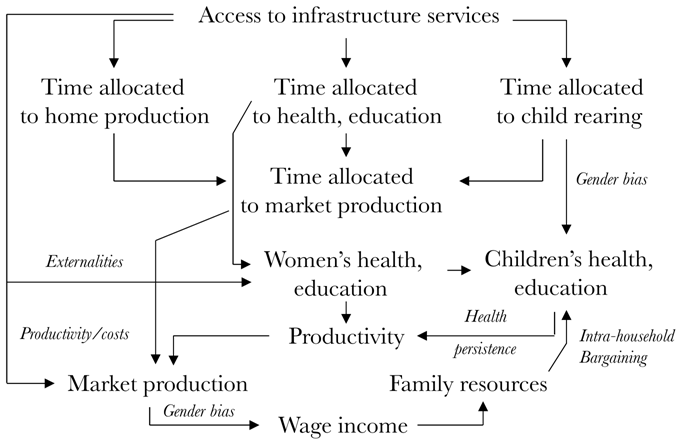The role of women in economic development continues to occupy centre stage in policy debates. As documented in a number of studies, including the World Bank’s recent World Development Report 2012, gender inequality – in terms of access to education, health, formal sector employment, and income – remains a significant constraint to growth in many countries. Although near-parity has been achieved in primary school enrolment in many countries, progress toward gender equality in secondary schooling has been slower. In some regions – sub-Saharan Africa in particular –secondary enrolment gaps have widened. Despite progress in recent years, women and girls account for six out of ten of the world’s poorest and two thirds of the world’s illiterate people. In today's low- and middle-income countries, the labour force participation rate for women remains low and large pay differentials continue to prevail between men and women (UN WOMEN 2011, International Labour Organization 2012).
Because gender inequality is unlikely to fix itself, there is also broad agreement that a wide range of gender-based policies, motivated by both equity and efficiency considerations, may be needed in the years to come (Duflo 2012). However, there has been limited effort so far to develop practical tools that would allow policymakers to assess the impact of these policies, and ultimately quantify their effect on economic growth. Studies based on cross-country differences, while informative, have proved to be of limited use for policy design because they often do not identify the causal link from gender inequality to growth (Bandiera and Natraj 2013).
Infrastructure and women’s time allocation
Just like gender equality, the role of infrastructure in the process of economic development has received renewed attention in the ongoing debate over how to promote growth in low-income countries.1 In addition to the conventional positive effects on factor productivity and private investment, more recent evidence suggests that access to infrastructure may have a significant impact on health and education outcomes. In addition, a number of empirical studies have documented that improved access to infrastructure may have a significant impact on women's time allocation; in turn, changes in women’s time allocation may have substantial effects on growth, both directly and indirectly. For instance, on average women in rural sub-Saharan Africa spend between four hours and ten hours a week fetching water and firewood (see Table 1). Including other household chores, women may be forced to allocate up to six hours a day to home production activities – thereby constraining their ability to invest in their health, in the health of their children, and to engage in market work.
Table 1. Average time per week spent fetching wood and water, rural areas of selected sub-Saharan African countries (hours)
Source: United Nations Development Programme (2011).
By implication, better access to infrastructure may enable women to devote more time to market activity, thereby promoting growth. At the same time, it may lead to improved learning monitoring (for instance, in the case of electricity) as well as improved childcare practices. These improvements may strengthen the health status of children and their ability to learn and, in turn, this would improve their productivity in adulthood and their earning potential.
An overlapping generations model of gender and growth
In a series of contributions, we have developed a gender-based overlapping generations model to address interactions between infrastructure, women’s time allocation, and economic growth.2 Key features of our model include:
- Women allocate their time between four alternatives: market work, raising children, human capital accumulation, and home production.
- Home production combines women's time allocated to that activity with infrastructure services.
- In families, fathers have a relatively higher preference for current consumption, whereas mothers have a higher preference for children’s health, thus family-wide preference parameters for consumption and children’s health depend on women’s bargaining power.
- Gender bias in the workplace is captured by assuming that women earn only a fraction of their marginal product, and differences in economic outcomes in the market place between men and women are fundamentally related to gender bias experienced in the home during childhood.
- Women’s bargaining power depends on the relative levels of human capital of husband and wife, and thus indirectly on access to infrastructure, which influences women’s time allocation and thus the time that they allocate to human capital accumulation.
- Inter- and intra-generational health persistence, in the sense of women’s health affecting the health of their children, and health in childhood affecting health in adulthood.
The main linkages in the model (assuming that women also allocate time to their own health) are represented in Figure 1. It illustrates the fact that in addition to conventional productivity and cost effects associated with access to infrastructure, such access can also generate important externalities in terms of health and education outcomes, as documented by a wealth of evidence (see Agénor 2012b). A key relationship that the figure illustrates also is the inverse link between time allocated to home production and access to infrastructure. It implies that time allocated to own health or education, and time devote to child rearing (which are all productive in this setting) are positively related to access to public capital. Thus, one of the key channels through which infrastructure affects growth operates through women’s time reallocation.
The model produces equilibrium values for women’s time allocation, health and education outcomes, and an explicit expression for the economy’s growth rate in the long run. These static, long-run relationships are then calibrated (using a variety of data sources) and simulated.
In the case of Brazil, the results of the calibration exercise show that in the benchmark scenario women allocate 20.6% of their time to home production, 11.7% to child rearing, 18.5% to human capital accumulation (including both formal schooling and post-schooling time), and 42.1% to market work.
Figure 1. Main linkages in the overlapping generations model
An application to Brazil
To illustrate the role of gender-based public policy in the model, we apply the model to Brazil.3
Despite significant economic achievements in recent years – notably, in reducing poverty and income inequality gender inequality remains high. Gender gaps in access to formal employment and market income still persist in Brazil. The proportion of women with formal jobs increased from 41.5% in 1999 to 48.8% in 2009, but it is still lower than that of employed men, which stood at 53.2% in 2009. In 2008, women's wages were 84% of men's and the gap increases at higher levels of education. Among those with 12 or more years of schooling, women earned merely 58% of men's salaries. According to the Gender Inequality Index (GII) introduced by the UN, in 2011 Brazil's rank is only 80 out of 187 countries, with a score of 0.449 – the same as it was in 2008. The Gender Gap Index developed by the World Economic Forum since 2006 gives similar results.
Equally important for the present purpose, Brazilian women (even those working full time) continue to bear the brunt of time allocated to family chores: in 2008, they devoted an average of 25.1 hours per week to caring for their families and housekeeping, whereas men devoted an average of only ten hours per week to such tasks.
To illustrate the role of gender-related and gender-based public policy on economic growth in Brazil, and how these policies affect women’s time allocation and bargaining power, we conducted two experiments:
- Improved access to infrastructure.
- A reduction in gender bias in the market place.
Improved access to infrastructure
Consider the case of a public policy aimed at promoting access to infrastructure by investing in rural roads, power grids, and others. The direct effect of this policy is of course an increase in the public-private capital ratio, which therefore promotes growth directly. In addition, this increase reduces mothers’ time allocated to home production and raises time allocated to market work, human capital accumulation, and child rearing. The latter is also productive; it leads to improved health in both childhood and adulthood. Thus, all of these effects also help promote growth and health outcomes.
Crucially, the increase in time devoted to human capital accumulation raises women’s bargaining power, which translates into a higher family preference for girls’ education and children's health, an increase in the average share of family income spent on children, and a lower preference for current consumption. The first two effects increase further the amount of time allocated to education and child rearing, whereas the last effect contributes to a rise in the savings rate. Because increases in the level of income and in the savings rate raise private savings and the private capital stock, there is a positive effect on the growth rate of outputs. At the same time, female health in adulthood also improves – as a result of receiving more care in childhood and higher government spending on health.
In quantitative terms, the numerical experiments focused on a policy that takes the form of a budget-neutral increase in government spending on infrastructure investment, from its current value of about 2.1% of gross domestic product (GDP) to 3.1% of GDP. Calculations suggest that this policy could add between 0.5 and 0.9 percentage points to Brazil’s annual rate of output growth once direct and indirect effects – most notably through changes in women’s time allocation and their bargaining power over family resources – are accounted for. This positive effect could be even higher if the increase in the share of spending of investment is accompanied by reforms aimed at improving the quality of such spending. Thus, a policy aimed at promoting access to infrastructure could have a substantial impact on the population’s standards of living over a relatively short time horizon.
Reduction in gender bias in the market place
Suppose now that the government introduces antidiscrimination laws that lead to a complete elimination of gender bias against women in the workplace. Women’s ‘take-home’ pay therefore increases, all else being equal. The direct effect of this policy (at the initial level of wages) is to raise family income. In turn, higher income leads to a higher level of private savings and higher private capital stock, which has a direct positive effect on growth and brings higher tax revenues. Because changes in the degree of gender bias in the workplace affect tax revenues and private savings in exactly the same way, the public-private capital ratio is not affected, nor is women's time allocation. Nevertheless, because higher tax revenues lead to higher public spending on health, there is a positive effect on health in childhood and female health in adulthood. Thus, a reduction in gender bias leads to an increase in the growth rate of output and improved health outcomes.
In quantitative terms, the model-based calculations suggest that an ‘equal work, equal pay’ policy that would ensure that women earn a wage that fully reflects their marginal contribution to market production could add up to 0.2 percentage points to the country’s annual growth rate. Over a sufficiently long period of time, this would also have a significant impact on the population’s standards of living. In addition, it is important to note that the analytical framework from which this estimate is derived does not capture the possibility that gender gaps in access to managerial positions and employment may also distort the allocation of talent and women’s incentives to invest in particular skills, thereby constraining overall productivity growth. If these effects were to be accounted for, the growth benefits of eliminating gender bias in the market place would be even higher.
Conclusion
Our approach calibrates the steady-state solution of the model – based on rigorous microfoundations and which possesses well-defined long-run properties – and focuses on the long-run effects of gender-based policies. Many of these policies are structural in nature and are likely to produce tangible economic results but only over a period of several years. While the model described here may not provide complete versatility, it does represent a significant analytical step forward in an area where there is a dearth of quantitative tools available for policy analysis.
References
Agénor, Pierre-Richard (2012a), “A Computable OLG Model for Gender and Growth Policy Analysis,” Working Paper No. 169, Centre for Growth and Business Cycle Research, June.
Agénor, Pierre-Richard (2012b), Public Capital, Growth, and Welfare, Princeton, New Jersey, Princeton University Press.
Agénor, Pierre-Richard, and Madina Agénor (2009), “Infrastructure, Women’s Time Allocation, and Economic Development,” Working Paper No. 116, Centre for Growth and Business Cycle Research.
Agénor, Pierre-Richard, and Baris Alpaslan (2013), “Child Labor, Intra-Household Bargaining and Economic Growth”, Working Paper No. 181, Centre for Growth and Business Cycle Research.
Agénor, Pierre-Richard, and Otaviano Canuto (2012a), “Access to Infrastructure and Women’s Time Allocation: Evidence and a Framework for Policy Analysis”, Policy Paper No. 45, FERDI.
Agénor, Pierre-Richard, and Otaviano Canuto (2012b), “Measuring the Effect of Gender-Based Policies on Economic Growth”, Economic Premise 85, World Bank, Washington, DC.
Agénor, Pierre-Richard, and Otaviano Canuto (2013a), “Gender Equality and Economic Growth in Brazil: A Long-Run Analysis”, Policy Research Working Paper No. 6348, World Bank.
Agénor, Pierre-Richard, and Otaviano Canuto (2013b), “Gender Equality and Economic Growth in Brazil”, Economic Premise 109, World Bank, Washington, DC.
Agénor, Pierre-Richard, Otaviano Canuto, and Luiz Pereira da Silva (2012), “On Gender and Growth: The Role of Intergenerational Health Externalities and Women's Occupational Constraints”, unpublished, University of Manchester.
Bandiera, Oriana, and Ashwini Natraj (2013), “Does Gender Inequality Hinder Development and Economic Growth? Evidence and Policy Implications”, World Bank Research Observer, 28 (February), 2-21.
Dinkelman, Taryn (2011), “The Effects of Rural Electrification on Employment: New Evidence from South Africa”, The American Economic Review, 101, December, 3078-108.
Duflo, Esther (2012), “Women Empowerment and Economic Development,” Journal of Economic Literature, 50, December, 1051-79.
Ghani, Ejaz, William Kerr, and Stephen D O’Connell (2013), “Promoting Women’s Economic Participation in India”, Economic Premise No. 107, World Bank.
International Labour Organization (2012), Global Employment Trends for Women, ILO Publications, December.
Koolwal, Gayatri, and Dominique van de Walle (2010), “Access to Water, Women's Work and Child Outcomes”, Policy Research Working Paper No. 5302, World Bank.
United Nations Development Programme (2011), Human Development Report 2011, New York.
UN WOMEN (2011), Progress of the World’s Women 2011-2012: In Pursuit of Justice, United Nations, New York.
World Bank (2011), "Gender Equality and Development", World Development Report 2012, Washington DC.
1 See Agénor (2012b) for a detailed overview of the literature on infrastructure and growth. On the issue of infrastructure and women’s time allocation, see Koolwal and van de Walle (2010), Dinkelman (2011), and Ghani et al. (2013), for country-specific evidence, and Agénor and Canuto (2012a) for a broader review. Agénor and Alpaslan (2013) study how lack of access to infrastructure may lead to child labor for girls.
2 The model, which dwells on Agénor and Agénor (2009) and Agénor et al. (2012), is described in detail in Agénor (2012a) and Agénor and Canuto (2013a). It is summarised in Agénor and Canuto (2012a, 2012b).
3 See Agénor and Canuto (2013a, 2013b) for a more detailed discussion.





